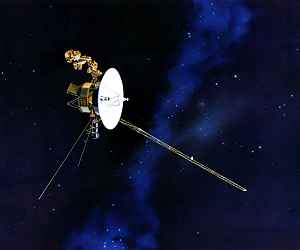SSR- Distance measurements to satellites
SSR- Distance measurements to satellites
Navigation in space, i.e. determination of the position or distance to a satellite can take place only using one of the different radar methods. For very large distances, as for example from Voyager 1 and Voyager 2, a primary radar is not possible due to the huge distances (2· 1010 km). According to the fundamental radar range equation, unreal antenna dimensions and transmit powers would be necessary. Therefore, only the secondary radar procedures can be used for very long distances.[1][2]
Voyager has a special transponder on board for these purposes. A ground interrogator transmits the interrogation (“uplink”) in the S-Band, with a carrier frequency of 2.11 GHz. The transmitted power is about 20 kW. A simple keyed on/off pulse modulation, however, would require too large bandwidths in the transmission / reception technique to avoid to loose the pulse edges which are relevant for the run time measurement. Therefore, a special pulse pattern is transmitted, which is converted by the transponder only to a different frequency. The transponder processes this signal fully coherently. This means: the received uplink frequency is used originally and only converted into a different frequency. The conversion ratio is exactly 240/221, so the downlink is about 2.3 GHz. At the same time it is also converted into another frequency band: The conversion ratio is here 11/3, the downlink is thus in the X-Band at approximately 8.42 GHz.[3] The high gain antenna on the voyager probe has a diameter of 3.7 m. or 12 feet. Its antenna gain is 36 dBi in S-Band; respective 48 dBi in X-Band.
Back into the interrogator, the received response is correlated with the copy of the transmitted signal stored in a time grid of an atomic time clock, thus determining the exact run time (plus the well known response time of the transponder). In this way, the distance can be determined very precisely. However, this measured distance was valid only for the time of the transponder activity, since the running time of the signals is already in the range of more than one day and Voyager continues to fly at a speed of 62 140 km/h.[4]
Originally this response was based on two different frequency bands in order to be able to correct the influences of the ionosphere on the propagation velocity of the electromagnetic waves. Later, however, the relativistic gravitational time delay effect (Shapiro delay) for the radar signals could also be measured with a very high accuracy.[3]
Deep Space Navigation Network
In order to measure even a single satellite, an entire system of antennas is needed on Earth, the Deep Space (Navigation) Network (DSN). The antennas are distributed in such a way that at least one antenna can always be swiveled in precisely the direction from which the transponder response is expected. Since the run times are so high (currently 1.5 days), the probability be too high, that a single large antenna is on the wrong side of the Earth due to the earth rotation.
If several interrogators or several transponders are used, all hardware must be able to use a standardized protocol. The antennas of the interrogators have got a diameter of 70 m and are located in Goldstone (California), in Madrid (Spain) and Canberra (Australia). The transponders are also standardized and are, for example, called Small Deep Space Transponders (SDST) or only Deep Space Transponders (DST).
A very high frequency band is selected as the carrier frequency (X-Band to Ka-Band), so that the antenna can have as great a directivity as possible for smaller geometric dimensions. Older one transponders use the S-Band, which allows minimal propagation loss through the Earth's atmosphere (less than 1 dB). This is usually quite adequate for Earth-orbiting missions.
On the NASA page Deep Space Network now you can discover exactly what each antenna is up to and what spacecraft it's communicating with. There, for example, it is stated that the received power of the response signals of the Voyager spacecrafts is in the range of -160 dBm.
Sources and ressorces:
- Udo Renner; Nikolaos Balteas; Joachim Nauck, ''Satellitentechnik: Eine Einführung'' Springer, Berlin, Heidelberg, 1988., ISBN 978-3-642-83149-2, S. 77 (online preview)
- A. Winton, J.-L. Gerner, P. Michel, & R. Morgan-Owen: ''The Transponder - A Key Element in ESA Spacecraft TTC Systems'' ESA Bulletin Nr. 86. Published May 1996. (online)
- Timothy P. Krisher, John D. Anderson, Anthony H. Taylor, “Voyager 2 Test of the Radar Time-delay Effect,” Astrophysical Journal, Part 1 (ISSN 0004-637X), vol. 373, June 1, 1991, p. 665-670. (online preview)
- “Where are the Voyagers?” see: NASA-Project

